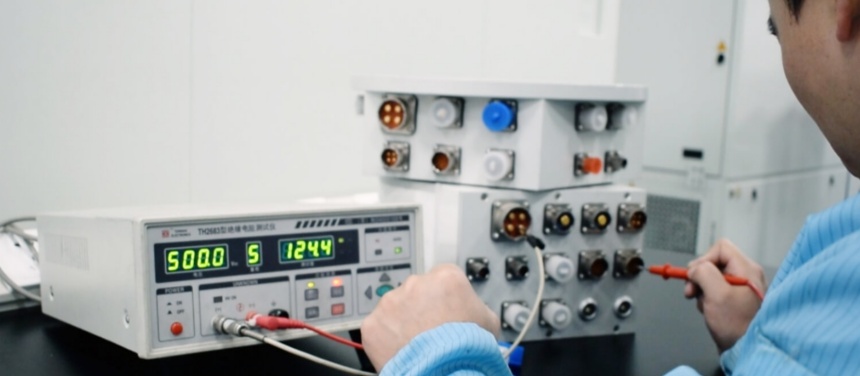Often underappreciated for their size, slip rings bear the weight of significant roles within electronic systems. At its core, a slip ring is a unique device designed to transmit power, as well as electrical signals, from a stationary source to a rotating object. This ability to allow electrical connections to spin unhindered paves the path for countless inventions and industrial applications.
In the context of aerospace and aviation, slip rings take a step further into the limelight. The industry demands constant communication and transmission of power, all while components rotate or spin. Consequently, slip rings become an integral and mission-critical cog. Tasks that range from enabling flight controls, facilitating radar operations, empowering satellites, and more, are a testament to the underpinning role slip rings play in aerospace and aviation equipment.
This introduction lays the groundwork as we thoroughly examine the pivotal role of slip rings in aerospace and aviation. We will explore their vital operations, address the challenges for their implementation, and anticipate their future in the expansive realm of aerospace and aviation applications. Our journey will elevate our understanding and knowledge, navigating through the intricacies of technology employed thousands of feet above us.
Importance of Slip Rings in Aerospace and Aviation
As technology advances, digital communication and power system requirements in aviation and aerospace increase in complexity and importance. Without the efficient transmission of power and signals to needed parts of aircraft, radar systems, satellites, and more, these systems simply cannot function. This is where slip rings, with their ability to allow an uninterrupted flow of data and power to even the rotating parts, assert their cruciality.
For operations in the aerospace and aviation sectors, slip rings are more than just pivotal – they are indispensable. They sit at the heart of vital movements, where machinery parts rotate on one axis. Their primary function involves the transmission of power as well as data signals while conforming to the rotary motion. They are responsible for the electrical bridge between the stationary source and the revolving equipment, enabling the unhindered flow of power, critical information, and communication signals.
In an industry where precision, accuracy, and reliability are paramount, slip rings deliver in full measure. Their robust construction and meticulous design cater specifically to the heavy demands of applications in aerospace and aviation. The underlying essence of their role truly exemplifies the saying that big things often come in small packages.
Navigating further, we will embark on the numerous applications of slip rings that prove their indispensability in aerospace and aviation technologies. Bearing a deeper understanding of these complexities will shed more light on their importance.

Common Applications of Slip Rings in Aerospace and Aviation
In a world where the horizon is marred by technological applications, slip rings in aerospace and aviation emerge as the heroes, silently ensuring the smooth flow of power and data.
Starting with Radar Systems, their significance in tracking, surveillance, and navigation is monumental. To maintain continuous tracking or surveilling capabilities, the radar needs the ability for constant rotation. Slip rings make this possible. Mounted in the rotational axis of the antenna, they transmit electrical power and signals from a stationary platform to the revolving radar systems. This facilitates continuous rotation and non-stop transmission of data, making all-weather guidance and navigations possible, and are at the heart of many flight and security operations.
Satellites and Space Systems are another intriguing frontier where slip rings strut their worth. Precision antenna systems, solar panel deployments, and gimbal systems rely heavily on them. The solar panels that power spacecraft need to position themselves optimally towards the sun, and during this rotation, slip rings come into play, enabling rotational motion while ensuring consistent power transmission. Similarly, satellite antenna systems and gimbals use slip rings to allow rotational motion without hampering the communication and data transfer needed for mission success.
Aircraft On-board Systems are laden with examples of slip ring application as well. The intricate navigation systems that guide aircraft through complex routes hinge on the information transmitted via slip rings. Flight controls, performing the myriad of small and large adjustments necessary for safe and efficient flight, tap into the slip ring’s potential for unhindered power and data movement. Wind turbines, a critical energy system within aerospace applications, also use slip rings to transfer power and control signals from the stationary structures to rotating blades.
Hence, across the breadth of aerospace and aviation applications, slip rings demonstrate a myriad of applications. Their role makes them a silent, yet instrumental part of a large mechanical symphony that allows us the miracle of flight and exploration of the celestial realms.
Design Considerations for Aerospace and Aviation Slip Rings
The considerations that go behind the design of slip rings for aerospace and aviation pivot around the unique and challenging environments that these devices have to operate in. These spaces are characterized by severe conditions – extreme temperature variations, pressure differences, intense vibrations, and dynamic atmospheric conditions.
Facing temperatures that vary from extremely cold to unimaginably hot, slip rings used in high-altitude aircraft or spacecraft must be resistant to temperature fluctuations. Furthermore, their design must also account for changes in pressure, from the vacuum of space to the high pressures found during rapid changes in altitude. In the midst of these variables, aircraft and spaceships experience intense vibrations during launch, navigation, and landing, and slip rings must be G-force resistant and sturdy enough to withstand these vibrations without sacrificing performance.
These challenging factors necessitate specialized designs and material selections for slip rings intended for aerospace and aviation applications. Materials chosen have to offer a high degree of thermal stability, resistance to varying pressure levels, and resilience to vibration stresses. Not only must they be durable, but also lightweight, owing to the premium placed on all weight in such applications.
Engineers, thus, have to channel their efforts into designing and fabricating slip rings that are both light and robust, meeting strict safety, reliability, and lifespan standards of the industry, alongside ensuring their high performance. Typically, these slip rings are crafted with the utmost attention and precision, utilizing advanced materials and technology to create an electromechanical device that is primed for vigorous performance and long endurance in high-intensity environments.
These unique designs serve to amplify the operating efficacy of slip rings, ensuring that they withstand the toughest demands of aerospace and aviation applications. The road to survival for slip rings in these sectors is paved with extensive customization, intense testing, and a commitment to quality that undergirds their vital role in this rapidly evolving industry.

Slip Rings in Aerospace and Aviation: Technical Challenges and Solutions
Conquering the skies or foraying into the realm of space is fraught with challenges, and slip rings in the aerospace and aviation sector stand at the forefront of these technical complexities.
The most prominent challenge faced is the extreme environmental conditions. Sharply fluctuating temperatures and pressure, coupled with intense vibrations, demand that the slip rings be robust enough to withstand them all. Another issue revolves around the need for miniaturization – aerospace and aviation equipment require smaller, more lightweight components to maintain optimal flight performance yet, small size can’t be at the expense of effectiveness or durability.
Furthermore, as we advance into the age of fast data, high-speed data transfer has emerged as a significant requirement. With burgeoning advancements in radar systems and satellite communication, the need for impeccable and swift data transfer is more crucial than ever.
It is, therefore, the need of the hour to confront these challenges head-on. Material development and engineering design advancements are continuously helping to meet these hurdles. Innovations like fiber optic rotary joints (FORJs) are introduced for high-speed data transfer, ensuring minimal loss and maximum effectiveness. To resist extreme temperatures and vibrations, technologists are experimenting with a variety of resilient materials, specific molding techniques, and advanced encapsulation methods.
Paving the way for miniaturization, engineers are increasingly employing compact designs and utilizing new conductive alloys that allow smaller contacts without compromising on power handling. As a result, these smaller, more efficient slip rings are helping to maintain aircraft performance while supporting increasingly complex systems.
In essence, the quest to overcome these challenges is shaping the innovation landscape in slip ring technology. It’s a conduit pulling together scientists, technologists, and engineers, motivating them to enhance, innovate, and push the boundaries to make aerospace and aviation journeys safer and more efficient.
Future Trends of Slip Rings in Aerospace and Aviation
As the quest for technological advancement continues, we are on the cusp of perceiving some groundbreaking trends and developments in the realm of slip rings for aerospace and aviation. These advancements have the potential to reshape future applications and industry growth, promising new avenues of exploration.
One dominant trend is the further miniaturization of components. As space on aircraft and spacecraft continues to be at a premium, the push towards even smaller, lighter, but powerful slip rings is expected to intensify. Advances in material science, mechanical miniaturization, and nanotechnology are anticipated to facilitate this downsize while maintaining, if not enhancing, the performance and durability of these components.
Furthermore, as applications become more data-centric with the advent of real-time monitoring systems, autonomous navigation, and similar advanced technologies, the need for high-speed data transfer becomes paramount. Thus, the integration of fiber-optic capabilities within slip rings is anticipated to become a significant trend, addressing the need for swift, accurate, and high-volume data transmission.
Moreover, advancements in non-contact slip rings are also on the rise. Known for their reduced wear and friction and extended operational life, capacitive, inductive, and optical slip rings add a new spin to the traditional contact-ring design and might become the future norm.
The future of slip rings also seems intertwined with the advent of ecological and sustainable technology. With the industry pushing towards more eco-conscious decisions, designing slip rings from environmentally friendly materials that embody the ‘green tech’ approach will likely surface as a prominent trend.
These future trends and technological advancements are set to redefine the landscape of aerospace and aviation, paving the way for enhanced functionality, increased efficiency, and smoother operations. And as these innovations integrate into the industry, they will undoubtedly contribute towards a more advanced, resilient, and sustainable future.
Conclusion
As the giants of the sky rely on this small yet mighty component, understanding its functionality, applications, and future trends becomes crucial for key stakeholders in the industry. The integral role of slip rings in aerospace and aviation is undebatable, driving more investment and innovation into their technological advancement, assuring that slip rings, just like the aircraft they so essential enable, are always taking off towards new horizons.
Looking for a specific slip ring solution? Let us know your requirements through this form.


